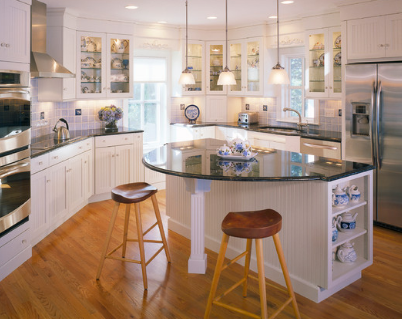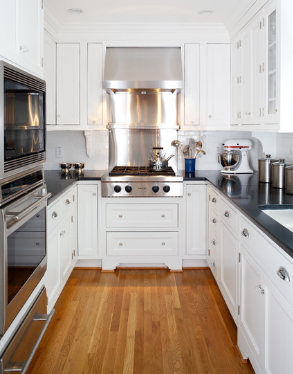For some homeowners, the kitchen work triangle can feel mysterious. The term is often mentioned in kitchen design – but is it necessary? Since appliances can easily become the most expensive part of a kitchen remodel, deciding what is right for your new kitchen and where it will be placed is an important personal decision. These pro tips from four architects and designers can help you figure out which equipment layout is right for you.
Do You Need a Working Triangle?
“The work triangle is important, but it’s not the only solution,” says interior designer Alison Glenn. Traditionally, kitchen layouts revolve around a basic connection between a refrigerator, stovetop, and sink. While this shape allows you to have everything at your fingertips while cooking, following it too strictly can actually complicate the design of your kitchen.

“A kitchen work triangle doesn’t have to be a triangle,” says architect Hiromi Ogawa. “I think it’s called a triangle so that people understand that these three parts work together. But the most important thing is the workflow, which can vary depending on the space and the needs of the owner.”
Most importantly, make sure that the route between the three work centers (preparing, cooking, and cleaning) remains clear and direct. “It’s okay to spread them out, but make sure the chef doesn’t have to go around the island from one location to another,” says architect Heather McKinney.
For larger kitchens, these work centers can be divided into different areas and have their own working triangles. The prep sink may be located next to the refrigerator, while the microwave and clean-up area may be closer to the main sink.

Some appliances that are not commonly used are best placed away from the main work area of the kitchen. If the hob is central, the wall-hung stove can be set remotely. Make sure to divide the kitchen into cooking and social areas. “If you can stop the circulation in the chef’s work area, it really helps keep the kitchen feeling and functioning more efficiently,” McKinney says.

Select the Size of the Appliance
“It’s important not to pay too much attention to appliances or cabinets,” Ogawa said. “Let them inform each other.” Sometimes, large equipment can compromise storage or counter space. If you have to compromise on something because of a device, ask yourself if the device (no matter how much you like it) really needs to be that big.

While a 30-inch oven is standard in the United States, much of Europe has an oven size close to 24 inches. Architect Amy Alper suggests that if space is scarce, opt for an oven that falls somewhere between the two sizes (about 27 inches wide). These smaller ovens heat up quickly and are very economical.

Glenn recommends keeping your appliances in proportion to each other. A 48-inch refrigerator can end up overpowering a 30-inch refrigerator. Placing a huge refrigerator outside the counter will not only interfere with your traffic space, but it will also affect your travel. It’s also ugly.
Alper also suggested looking into under-counter appliances. While they’re usually more expensive because they need to be built-in, they help minimize counter clutter and are easily accessible. Countertops are often suitable for storing appliances that are not used every day and can be stored most of the time.

Small Kitchen
Appliances can be tricky in kitchens with limited area. While a smaller kitchen may have a simpler working triangle, sometimes it doesn’t fit into the layout. Even so, the smaller size allows everything to be easily reached.
“The style of the kitchen and the available space sometimes determine how to achieve the best overall space,” says Glenn. If you can’t use a triangular appliance in your small kitchen, make sure your food and tools are stored in the proper space – this can help improve your workflow. Alper suggests adopting the kitchen style as an alternative – placing the sink, oven and refrigerator on one wall, while the prep space on the opposite side can work well in a small kitchen.

Be honest with you how much space you can leave for your appliances. “I can’t think of any useful device that doesn’t require 2 feet of depth,” McKinney said. But also think carefully about what you really need. A stovetop and oven may provide more counter space for a kitchenette, but if you do need two wall ovens, stick with them. In the end, what works best for your home is always the most important.



